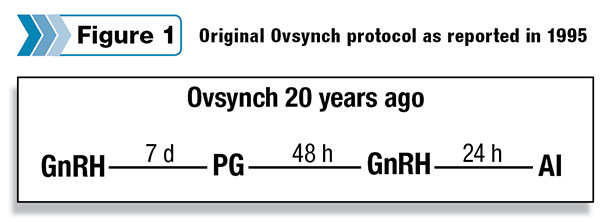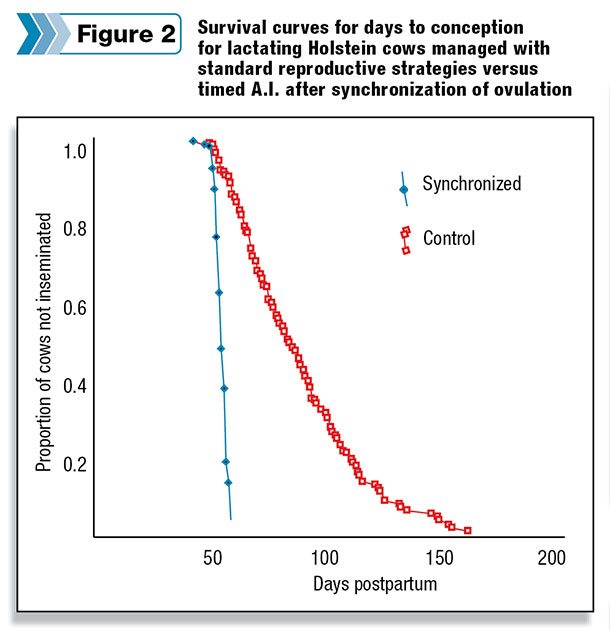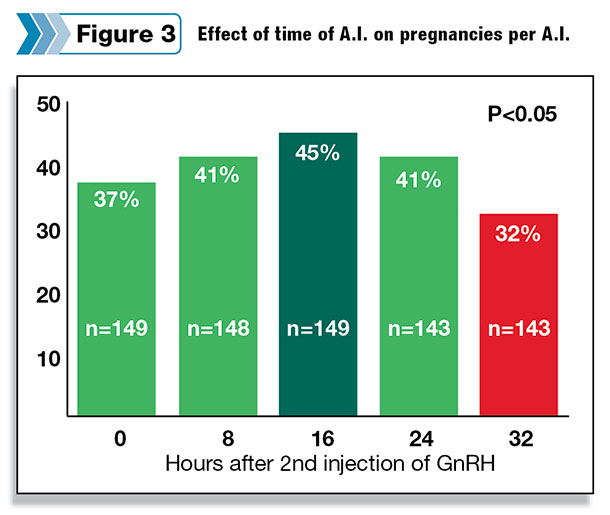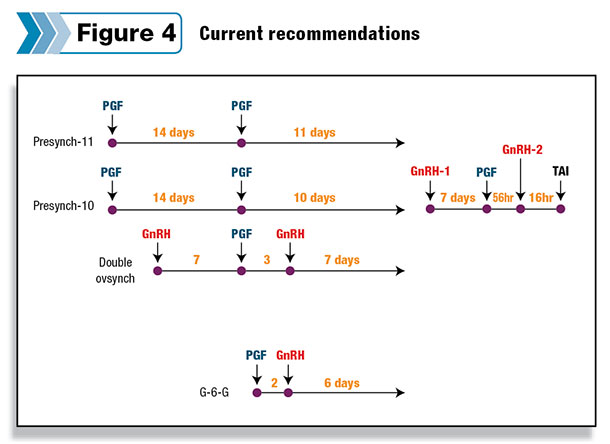Last November marked the 20th anniversary of the first publication on Ovsynch by J.R. Pursley, M.O. Mee and M.C. Wiltbank. It has been cited in 1,161 journal articles since. That article, in Theriogenology, introduced the idea that ovulation could be synchronized in an eight-hour period to potentially allow for acceptable fertility following fixed-time A.I. in dairy cows.
This article discusses the development of Ovsynch, the initial impact, how it was improved, how it became a model to understand the limitations to fertility of lactating dairy cows and how it is currently being utilized as part of fertility programs.
Development of Ovsynch
Prior to the development of Ovsynch, timing of estrus was controlled with prostaglandin F-2 alpha (PG). PG causes the regression of corpora lutea (CL). Time from treatment with PG until estrus is dependent upon stage of growth of the eventual ovulatory follicle at time of PG and ranges from two to six days. If the ovulatory follicle at the time of PG is in early stages of growth, time of estrus is delayed – and vice versa.
So in essence, ovulation was synchronized in cycling cows in approximately a four-day period using PG or a combination of PG treatments 10 to 14 days apart. This four-day window did not allow for a successful fixed-time A.I. since timing of insemination and ovulation must occur in a much shorter period due to the limited lifespan of sperm and oocytes.
In addition, PG will only have a chance to synchronize estrus if cows are cycling. About 25 percent of cows, or more, have not yet started cycling at 50 days postpartum.
We became very interested in the idea of manipulating development of follicles and CL in ovaries to control timing of CL regression and ovulation of a dominant follicle.
At first, our intent was to solve the problem of poor fertility of lactating dairy cows, which we thought was primarily due to the ovulation of a dominant follicle that had lived too long in the ovary.
Data from several prominent laboratories had emerged at that time indicating fertility was severely compromised if the dominant follicle persisted in growth in cattle.
In addition, it appeared there were differences in dairy cows and heifers in follicular wave dynamics in which dairy cows had ovulatory follicles that lived longer in the ovary compared to heifers. We thought if we could control the antral age of the follicle, we could improve fertility in dairy cows.
With this in mind, we created a series of injections with GnRH and PG (Figure 1) with the intent to reduce the age of the ovulatory follicle to improve fertility and control the timing of ovulation of that follicle to allow for a fixed-time A.I. to reduce days open.

It turned out that the original Ovsynch did not improve fertility of dairy cows. The major impact that Ovsynch had (and still has) was on controlling days to first service and its utilization as a way to resynchronize cows following a non-pregnancy diagnosis.
This impact alone completely changed the way cows were managed for reproduction in the U.S. and around the world. Ovsynch allowed for the replacement of the traditional voluntary waiting period with “time of first A.I.” selected by management – and in addition had the potential to completely eliminate the need for detection of estrus.
Impact
The next two Ovsynch studies were reported in the Journal of Dairy Science in 1997.
Both studies demonstrated fertility equivalence of Ovsynch to A.I. following estrus but, more importantly, demonstrated that Ovsynch reduced days to first service, more cows pregnant at 100 days in milk and greater chances of being pregnant at any stage postpartum (Figure 2), all a consequence of controlling time of first A.I.
Key improvements
The next study published in Journal of Dairy Science in 1998 was designed to determine the ideal timing of A.I. following the final GnRH of Ovsynch. Prior to this study, timing of A.I. was only tested relative to estrus. The outcome of those studies was the a.m./p.m. rule.
Our study tested the timing of A.I. relative to the GnRH-induced LH surge. In the original Ovsynch study, it was clear that ovulation occurred 24 to 32 hours after the final GnRH of Ovsynch. Our hypothesis was that A.I. around eight hours prior to ovulation would elicit the greatest pregnancy rate per A.I.
Previous published data indicated sperm need six to eight hours of time in the reproductive tract to go through the capacitation process to be capable of fertilizing the oocyte.
Results from this experiment revealed the greatest percentage pregnant per A.I. was 16 hours after the final GnRH (or about eight hours prior to expected time of ovulation; Figure 3). This experiment provided the fundamental data for recommending inseminating cows 16 hours after the final GnRH instead of 24 hours.

Pre-synchronization strategies developed by a number of scientists have enhanced the effectiveness of Ovsynch. These strategies enhance percentage pregnant per A.I. if they are designed to initiate Ovsynch on day 6 or 7 of the estrus cycle.
Treating with GnRH on day 6 or 7 of the estrus cycle increases the chances of ovulation, increases circulating progesterone during the growth of the pre-ovulatory follicle and allows for control of the age of the ovulatory follicle and luteolysis.
Pre-synchronization strategies that induce the greatest percentage of cows to day 6 or 7 of the estrus cycle are Double Ovsynch, G6G and Presynch-10 or 11 (Figure 4).

We now refer to these strategies as “fertility programs” since percentage pregnant per A.I. is increased approximately 50 percent compared to Ovsynch alone and A.I. following a detected estrus (48 percent versus 32 percent).
Other key changes in Ovsynch came about following studies that determined the ideal timing from PG to final GnRH. Ovsynch-56 allowed for the reduction in time from GnRH to A.I. from 24 to 16 hours and maintained a.m. breedings.
It also allowed for a greater maturation of the pre-ovulatory follicle during the period from PG to GnRH (increased from 48 to 56 hours). This greater maturation of the follicle likely increased circulating estradiol concentrations, which can enhance fertility.
It appears one of the most positive improvements made recently to Ovsynch was the addition of a second PG 24 hours after the original. Several published studies indicated that luteolysis following one PG (25 mg dinoprost or 500 ug cloprostenol) was effective in 79 to 86 percent of cows and more so in primiparous than multiparous cows.
A second PG increased the chance of luteolysis to 98 percent and increased pregnancies per A.I. from 47 to 53 percent in first-service cows in a study from 2009.
Current recommendations
It is highly recommended to utilize a pre-synchrony program with Ovsynch for first A.I. It ensures that all cows including the non-cycling cows will receive an A.I. at an optimal time in lactation with a greater chance for pregnancy compared to Ovsynch alone or detected estrus.
Ovsynch can be utilized as a tool for cows diagnosed not pregnant. If ultrasound is being utilized for pregnancy diagnosis, veterinarians can provide information regarding ovarian structures that can enhance the chances of a re-synched pregnancy.
If cows diagnosed not pregnant have a CL, Ovsynch is a good choice. A CIDR can be utilized in this case during the time between the GnRH and PG, but it is highly recommended to delay the insertion of the CIDR one day after the GnRH, then remove 24 hours after the PG.
If cows do not have a CL following not-pregnant diagnoses, utilize the GGPG program, which entails administering a GnRH injection one week before the first GnRH of Ovsynch. The current recommendations for first A.I. and cows diagnosed not pregnant are in Figure 4. PD
References omitted but are available upon request. Click here to email an editor.

-
J. Richard Pursley
- Professor of Animal Science
- Michigan State University
- Email J. Richard Pursley






